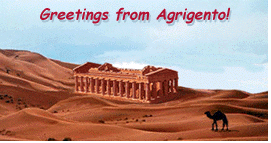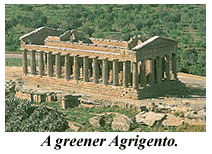...Best of Sicily
presents... Best of Sicily Magazine. ... Dedicated to Sicilian art, culture, history, people, places and all things Sicilian. |
by Carlo Trabia | ||
Magazine Index Best of Sicily Arts & Culture Fashion Food & Wine History & Society About Us Travel Faqs Contact Map of Sicily |
With their usual laxity, Sicily's politicians have been sluggish in addressing the problem. Proposed desalination plants have not been completed, while man-made lakes (from damming various streams) have been poorly integrated into the regional water supply system. The problem has provoked a national scandal. In a region whose prosperity depends in no small measure on tourism and agriculture, the water shortage is a serious matter. Sicily's ecosystem has not yet suffered extreme changes as a result of the current crisis (which the national government recently declared a state of emergency and which shows no sign of abating), but today's Sicily is not yesterday's. Until the sixteenth century, vast forests still covered many areas. That simply isn't true today. Entire provinces --Trapani, Caltanissetta, Agrigento, Enna-- are virtually without woodlands, and where woods exist in these areas, The closest desert drops its sands over Sicily in occasional rains following sciroccos --hot desert winds. That desert, the Sahara, formed naturally over many centuries, gradually developed its own ecosystem. Regions such as Sicily would not be so fortunate. The late response to the situation enrages Sicilian residents. After all, people have been aware of the changing climatic conditions for decades. The water problem is nothing new. Will a future postcard of Agrigento's ancient Temple of Concord feature a desert landscape? We hope not. Solutions to the problem exist. About the Author: Architect Carlo Trabia has written for various magazines and professional journals. | |
Top of Page |
 Will Sicily become a desert? Desertification is a slow process accelerated today by global warming, the damaged ozone and, in the case of Sicily, a dangerously diminishing annual rainfall and several centuries of deforestation. The water table is lower than ever. Fortunate are the Sicilians whose localities are blessed with underground springs. In the province of Agrigento (famous for its Greek temples), Italy's driest, water is rationed, supplied to homes for two or three hours once every few days or, in summer, every week or two (or three!), when tanks connected to automatic pumps are filled. It's the price paid for all of those cloudless days.
Will Sicily become a desert? Desertification is a slow process accelerated today by global warming, the damaged ozone and, in the case of Sicily, a dangerously diminishing annual rainfall and several centuries of deforestation. The water table is lower than ever. Fortunate are the Sicilians whose localities are blessed with underground springs. In the province of Agrigento (famous for its Greek temples), Italy's driest, water is rationed, supplied to homes for two or three hours once every few days or, in summer, every week or two (or three!), when tanks connected to automatic pumps are filled. It's the price paid for all of those cloudless days. they are protected by fences. Deforestation spelled the end of rivers. Outside the Etna region, today's Sicilian rivers are little more than seasonal runoff streams devoid of fish; the presence of frogs and eels is a rarity. As recently as the 1850s, the Platani, Belice and Imera were fished, and in ancient times, according to Greek records, they were navigable.
they are protected by fences. Deforestation spelled the end of rivers. Outside the Etna region, today's Sicilian rivers are little more than seasonal runoff streams devoid of fish; the presence of frogs and eels is a rarity. As recently as the 1850s, the Platani, Belice and Imera were fished, and in ancient times, according to Greek records, they were navigable.